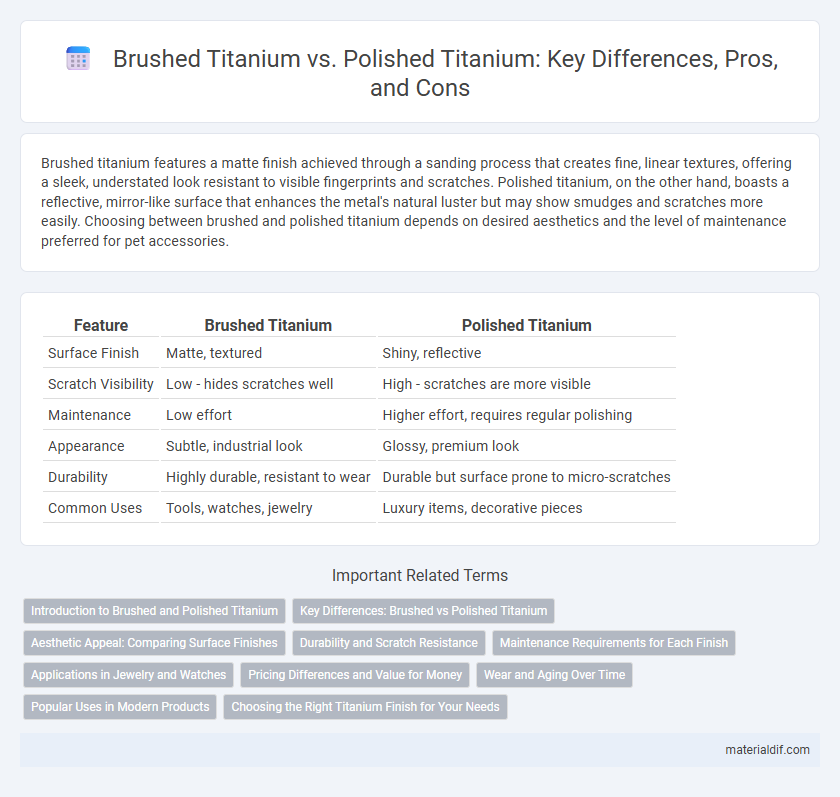Brushed titanium features a matte finish achieved through a sanding process that creates fine, linear textures, offering a sleek, understated look resistant to visible fingerprints and scratches. Polished titanium, on the other hand, boasts a reflective, mirror-like surface that enhances the metal's natural luster but may show smudges and scratches more easily. Choosing between brushed and polished titanium depends on desired aesthetics and the level of maintenance preferred for pet accessories.
Table of Comparison
| Feature | Brushed Titanium | Polished Titanium |
|---|---|---|
| Surface Finish | Matte, textured | Shiny, reflective |
| Scratch Visibility | Low - hides scratches well | High - scratches are more visible |
| Maintenance | Low effort | Higher effort, requires regular polishing |
| Appearance | Subtle, industrial look | Glossy, premium look |
| Durability | Highly durable, resistant to wear | Durable but surface prone to micro-scratches |
| Common Uses | Tools, watches, jewelry | Luxury items, decorative pieces |
Introduction to Brushed and Polished Titanium
Brushed titanium features a matte finish achieved through abrasive brushing, enhancing its resistance to fingerprints and scratches while providing a subtle texture. Polished titanium undergoes a polishing process that results in a glossy, reflective surface, highlighting the metal's natural luster and creating a sleek, modern appearance. Both finishes maintain titanium's renowned strength, corrosion resistance, and lightweight properties, making them popular in aerospace, jewelry, and medical applications.
Key Differences: Brushed vs Polished Titanium
Brushed titanium features a matte finish with fine, linear scratches that enhance its texture and reduce visible fingerprints, making it ideal for rugged or industrial applications. Polished titanium showcases a smooth, reflective surface with a high-gloss shine, providing a sleek and luxurious appearance often preferred in jewelry and high-end accessories. The primary differences lie in their aesthetic appeal, durability against scratches, and maintenance requirements, with brushed titanium offering superior resistance to wear while polished titanium demands more care to preserve its lustrous finish.
Aesthetic Appeal: Comparing Surface Finishes
Brushed titanium features a matte, textured surface created by fine abrasion, providing a subtle, understated aesthetic that reduces glare and hides scratches effectively. Polished titanium offers a reflective, mirror-like finish with high shine, enhancing the metal's natural luster and giving a sleek, modern appearance ideal for luxury applications. The choice between brushed and polished titanium depends on whether a rugged, muted look or a vibrant, glossy finish better suits the design intent and usage environment.
Durability and Scratch Resistance
Brushed titanium features a textured surface created by fine abrasive brushing, enhancing its scratch resistance and masking minor wear over time, making it more durable for everyday use. Polished titanium has a smooth, reflective finish that offers striking aesthetics but is more prone to visible scratches and requires more frequent maintenance to preserve its shine. Both finishes benefit from titanium's inherent strength and corrosion resistance, but brushed titanium is preferred for higher durability in rugged environments.
Maintenance Requirements for Each Finish
Brushed titanium features a textured surface that effectively conceals scratches and fingerprints, reducing the frequency of cleaning and maintenance compared to polished titanium. Polished titanium has a smooth, mirror-like finish that requires regular cleaning to maintain its reflective quality and is more prone to showing smudges and minor abrasions. Both finishes benefit from mild soap and water for cleaning, but brushed titanium demands less upkeep to preserve its aesthetic appeal over time.
Applications in Jewelry and Watches
Brushed titanium features a matte, textured finish that enhances scratch resistance, making it ideal for durable jewelry and watch cases that endure daily wear. Polished titanium offers a highly reflective, mirror-like surface prized in luxury watches and fine jewelry for its sleek, elegant appearance. Both finishes leverage titanium's lightweight, hypoallergenic properties, but brushed titanium is favored for sporty or casual styles, while polished titanium suits formal, high-end designs.
Pricing Differences and Value for Money
Brushed titanium typically costs less than polished titanium due to its less labor-intensive finishing process, making it a more budget-friendly option. Polished titanium demands additional polishing steps that increase manufacturing time and cost, resulting in a higher price point but offering a sleek, reflective finish favored for premium applications. Value for money depends on the intended use; brushed titanium provides durability and scratch resistance ideal for practical items, while polished titanium enhances aesthetic appeal, justifying its premium price in luxury products.
Wear and Aging Over Time
Brushed titanium exhibits better resistance to visible scratches and surface wear over time due to its textured finish, making it ideal for maintaining appearance in daily use. In contrast, polished titanium, with its smooth and reflective surface, tends to show scratches and signs of aging more prominently, requiring more frequent maintenance to preserve its shine. Both finishes offer excellent durability and corrosion resistance inherent to titanium, ensuring long-term structural integrity despite differing aesthetic aging patterns.
Popular Uses in Modern Products
Brushed titanium's matte finish is favored in wristwatches and eyewear frames for its understated, scratch-resistant surface that enhances durability and reduces glare. Polished titanium is commonly used in luxury automotive components and jewelry, where its reflective, mirror-like sheen highlights sleek design and premium quality. Both finishes benefit from titanium's lightweight strength and corrosion resistance, making them versatile choices for high-performance and aesthetic applications.
Choosing the Right Titanium Finish for Your Needs
Brushed titanium features a matte, textured surface that reduces glare and hides scratches, making it ideal for applications requiring durability and a rugged aesthetic, such as watches and cookware. Polished titanium offers a highly reflective, mirror-like finish that enhances visual appeal and is preferred for decorative items or jewelry where elegance and shine are paramount. Selecting the right titanium finish depends on your priorities for appearance, maintenance, and wear resistance, with brushed titanium excelling in practicality and polished titanium in luxury.
Brushed Titanium vs Polished Titanium Infographic

 materialdif.com
materialdif.com